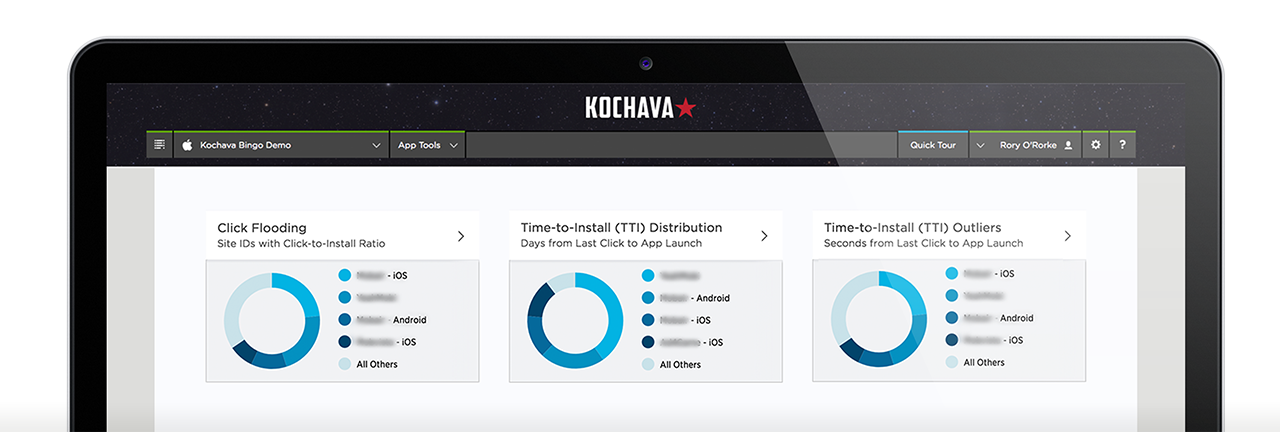Mobile’s rapid growth as the primary digital advertising platform has made it a hotbed for fraud, a costly part of mobile advertising campaigns. To stay ahead of mobile ad fraud, we at Kochava continue to develop and enhance our anti-fraud capabilities for mobile advertising. Today, we announced the addition of Install Authentication, a tool to validate installs before attribution, and three new views to the Fraud Console toolset.
“We’ve been identifying data abnormalities deemed potentially fraudulent for the past three years. During this time, we’ve been developing tools to identify fraud based on patterns,” said Grant Simmons, Director of Client Analytics at Kochava. “From what we’re seeing now, 84% of fraudulent clicks come from the 10 highest volume networks; and approximately 27% of installs on these networks have been flagged as fraudulent.”
Tools to prevent mobile advertising campaign fraud
In 2015, we started monitoring for ad fraud and developing tools to detect it. We then moved on to prevention, developing tools such as Traffic Verifier, the Global Fraud Blocklist, and now Install Authentication. These tools, customized by our customers, will help reduce suspicious entities from infiltrating campaigns.
“Marketers are accustomed to looking for install or conversion rates. They’re not used to questioning what they see. While those rates may initially look normal, there’s a good chance that at least a portion of the installs or conversions are fraudulent,” Simmons said.
The new tool “Install Authentication” identifies unverifiable installs and prevents the system from attributing them. Like many forms of ad fraud, faked installs may look legitimate on the surface. Installs and purchases may appear random and thus acceptable, but our algorithms can find the patterns that indicate which installs may likely be spoofed. The new feature is enabled through the Kochava SDK (Android 3.2.0, iOS 3.3.0, Windows 3.0.1 versions or greater) or server-to-server integration. It validates install receipts received by comparing them with identifiers associated with the receipts.
“With this feature, installs that don’t match are dropped before attribution happens, preventing spoofed installs from infiltrating campaigns,” Simmons said.
Customers have two options on how the authentication feature filters unverifiable installs:
- Strict: This option drops all unverifiable installs, regardless of SDK version
- Lenient: This option drops unverifiable installs for the eligible SDK versions
Three new Fraud Console views to detect

Early last year, we released the Fraud Console, a set of now 13 visualizations, for customers to review data anomalies flagged from across their accounts. The newest views include: Click Flooding, Time-to-Install (TTI) Outliers and TTI Distribution.
Click flooding is a form of fraud hiding behind many other types, such as sub-publishers or devices with high click volume. It occurs when networks or sub-publishers flood their channels with clicks to steal a user install from another source now specifically highlighted in the console.
TTI, or Time-to-Install, is a metric representing the time between a click and an install. The metric considers physical factors, such as network speed, and behavioral factors, such as incentivization. The TTI Outliers view flags networks/sub-publishers that fall outside of the normal range.
The new TTI Distribution view shows networks/sub-publishers that have had an increased number of installs outside of the normal range for a marketer’s apps. Any visualization, if deemed fraudulent, can be used by marketers as evidence for make-good requests with that network.
There is no single method to prevent fraud automatically, but marketers should incorporate our prevention and detection tools as part of their anti-fraud strategy. Last year, we added Traffic Verifier and the Global Fraud Blocklist to provide clients with real-time fraud prevention. Now Install Authentication adds to the robust prevention strategies developed by Kochava to protect your mobile advertising campaigns from known fraud.
Combine these prevention tools with the Fraud Console visualizations. If the data flagged in the console is deemed fraudulent, not only can you use this as evidence for make-goods, you can also export the flagged device IDs and network/sub-publisher IDs to add to your own Fraud Blocklists.
“Because the mobile ecosystem is unregulated,” Simmons said. “Everyone in the industry must use the resources available to mitigate fraud and report those entities they identify as fraudulent.”
For more information about mobile ad fraud detection tools available from Kochava, visit the Fraud Console and Traffic Verifier pages, or contact your Client Success Manager to enable Install Authentication.




